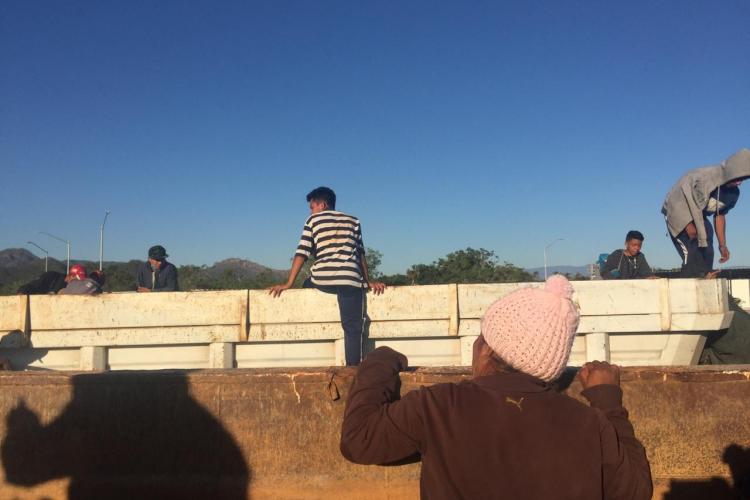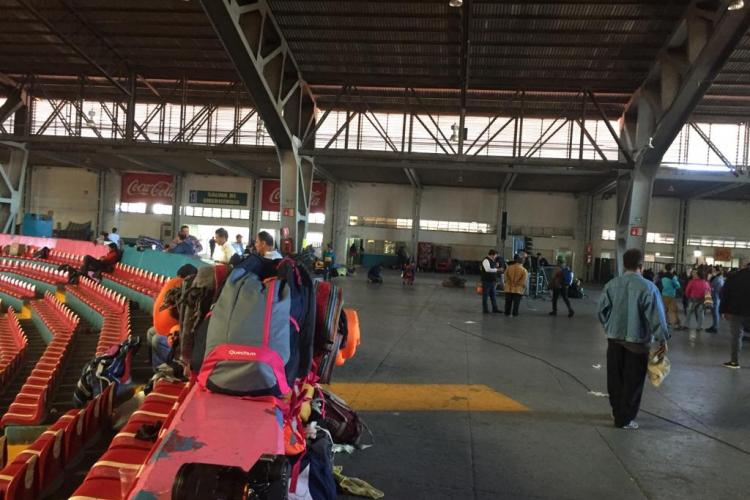The ‘Exodus’: A Brief Reflection on the Central American Migrant Caravan
Posted:
Time to read:
Guest post by Virginia Negro and Luigi Achilli. Virginia is a scholar on Latin American Studies at the National Autonomous University of Mexico (UNAM) in Mexico City, working on urban social movements and gender. Luigi is a Marie Curie fellow at the Global Governance Programme (GGP) at the European University Institute, whose research explores irregular migration facilitation. He has been traveling with the migrant caravan to the US Mexico border. In this post, we draw on open-ended interviews with migrants from the caravan during the journey to Tijuana. We also travelled with some of them from Mexico City to Sonora and sought to shadow their experiences.
The scenes of migrants breaking through the Guatemala-Mexico border earlier in October heading toward the US-Mexico border have generated much heat across the world over the past few weeks. Although evidence that terrorists and dangerous criminals are mixed in has not been provided, the White House has depicted the Central American caravan as a criminal menace and a security threat. The Trump administration’s vehement opposition and wild rhetoric should not mislead us to think that anti-migrant sentiments involve only the United States. On the other side of the Atlantic, similar concerns have been raised about the alleged connections between irregular migration and terrorism in the context of the so-called 2015 migrant crisis in Europe. And likewise, this assumption appears to be based only upon anecdotal information.

The idea that an unauthorized movement of people is deeply threatening and violent seem to rest on the widespread belief in Europe and the United States that migrations are fundamentally animalistic in nature, lacking any form of social contract. This representation obscures the role of border policies in the de-humanization of migrants, but it also fails to acknowledge the patterns of solidarity and cooperation that arise out of situations of profound political and humanitarian distress. These dynamics emerge clearly in the context of the current migrant caravan – the exodus of thousands of migrants, mostly but not only from Honduras, who left their countries to embark in a long journey toward the US-Mexico border.
The origin of the current caravan remains until now obscure. Despite the proliferation of rumors about éminences grises of different political colors being behind the caravan, the mass movement of central American migrants was most likely self-organized. Drawn in by the circulation of news, information, and images, growing numbers of people filled the ranks of a first caravan that left San Pedro Sula in Honduras on 13 October and which was exponentially bigger than the previous ones. Four more caravans followed suit, and together gained the appellative of ‘exodus’ mostly among civil society and media due to the uncommon number of people. By the end of November, roughly 8,000 caravan members had reached Tijuana and other urban centres around north-western Mexico.

The migrants we have spoken with claimed to have left their homes following a long-yearned desire of mobility and pushed by a combination of reasons: ‘I left like anybody else’, David (a pseudonym) admitted, shrugging his shoulders, ‘because it’s dangerous, because there are no jobs in my country’. David is a young man from Honduras, but his reasons were like those of anybody else we interviewed. In this sense, the current caravan is not a unique episode in the contemporary migration scenario. Other, yet smaller, caravans have preceded this one. Many of the veterans of the previous caravans, often pushed back by border control or stranded along the route, drifted into this one. Facebook, word of mouth, television footage, and WhatsApp played an important part. If anything, the novelty was that, unless previous caravans, this one was not preorganized by activists and NGOs. For example, the previous caravan in 2017 has been coordinated by the NGO Pueblos Sin Fronteras. In this sense, migrants have applied what they have learnt from the example set by the previous caravans to enhance independent moving. It should be, however, noticed that similar self-organized mass movements of people have recently involved other parts of the world. The 2015 migrant crisis in Europe is a case in point: around one-million people arrived on European shores mostly fleeing warfare and economic dispossession in Syria, Afghanistan and Iraq.
If the caravan/exodus model is becoming a new trend in migration, this can hardly be disentangled from the securitization turn and the progressive offshoring of border controls to third countries in the USA and Europe. The tightening of border controls and the adoption of increasing restrictive police measures by the US and Mexico – and the EU and its state members in the context of the ‘migrant crisis’ – have not meant the end of irregular migration. If anything, the dominant policy approach has led to a sharp rise in the cost of migration and to migrants’ reliance on guides of all kinds to reach their destinations. While independent moves become more hazardous as migrants opt for longer and therefore more dangerous routes, smuggling fees have invariably increased with the stepping-up of border enforcement along Mexico’s highways and northern and southern borders. This has made the services of smugglers become inaccessible for a growing number of would-be clients. As Pedro, a man in his late thirties who lived and worked in a migrant shelter in Mexicali, a city along the US-Mexico border, put it: ‘good smugglers are something for rich kids

Yet, the caravan is not only a strategy devised to reduce risks, it can also be an opportunity to live a meaningful life. For example, while for many the reasons of leaving their countries were deadly serious, fun and joy – and not only fear and desperation – were important and deeply enabling feelings that migrants experienced while on the move. Many of the migrants we met spoke of joining the caravan as an irresistible opportunity to experience life. Fun becomes not only a significant form of resilience that provides migrants with new creative ways to acquire a sense of normalcy; it also reinforces the networks and forms solidarities among migrants that ultimately determine and fashion their journeys and patterns of mobility. The journey is an expression of joy generated by a self-conscious awareness of being together and partaking of a similar experience, enabled by performing certain activities: singing, telling jokes, playing games, dancing, spending time together, falling in love, and even getting married. In this sense, the caravan has facilitated the creation of new bonds of friendship, mechanisms of solidarity, and also inner, personal growth.
The truth is that the caravans have certainly provided people with a way to ‘move forward’. Liberal democracies have a way of preventing ‘undesired populations’ from accessing fundamental rights – an ordinary exclusion that is legally produced through technologies of law, space and policing. Under the imperative of protecting the ‘smuggled victim’, the USA (and the EU) have designed more securitized practices of exclusion to thwart the very access of migrants to their national soil – an ambition that caresses the old fantasy of a sealed and impenetrable border: the outsourcing and externalization of asylum applications to third countries. The caravan has taken shape precisely to provide people fleeing the violence and economic dispossession with viable alternatives for survival other than situations that can be characterized as exploitative and abusive. While the caravan is certainly not the political threat depicted by Trump, the voluntary migration of bodies across borders that it prompted was neither passive nor apolitical. However, through the facilitation of irregular migration, migrants have displayed forms of agency that cannot be fully explained by universal schemata of force/power relations such as resistance-domination. In this sense, their capacity to act can be situated within what Reece Jones defines as ‘spaces of refusal’: ‘a range of activities that are not overt political resistance but nevertheless refuse to abide by the binary framing of state territorial and identity categories.’

However, we should be careful not to romanticize the caravan by misattributing to it forms of agency that can translate into a clear challenge to domination and control. If the caravan is born as a response to increasing restrictive measures to mobility, one of the consequences of the exodus was the exacerbation of the already US xenophobic discourse and its military response along the US-Mexico border. Similar negative repercussions can be observed in Mexico with the militarization of the Suchiate river on the southern border with Guatemala and the random deportation of central American migrants. Even more significant is the recent launch of the plan Quédate en Mexico’, which consolidates the US ambition to pursue the outsourcing and externalization of asylum responsibilities to third countries by seeking to process Central American asylum seekers’ case in Mexican territory. In this sense, we are left wondering whether the caravan has ultimately accomplished its goal of enhancing people’s mobility or, on the contrary, thwarted it by boosting the US security and border enforcement agenda.
Any comments about this post? Get in touch with us! Send us an email, or post a comment here or on Facebook. You can also tweet us.
__________
How to cite this blog post (Harvard style)
Negro, V. and Achilli, L. (2018) The ‘Exodus’: A Brief Reflection on the Central American Migrant Caravan
Share:








